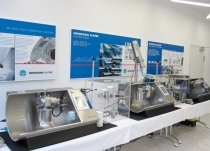Grinding and classifying of rare earth powders and their use in
enhancing quality in the manufacture of magnets
The NETZSCH company offers innovative solutions to this application problem with a patent pending grinding process with downstream classifying of rare earth powders. The design of this process led to the development of jet mills and ultra-fine classifiers with which sensitive Nd-Fe-B-compounds or other rare earth alloys can be ground reliably to fine powders under inert gas operation giving a narrow particle size distribution and defined upper particle size limit with reproducible results.
With NETZSCH M-Jet, a combination of a spiral jet mill with a dynamic air classifier, highest reproducible finenesses independent of the load in the gas jets are obtained. A decisive advantage of the M-Jet compared to fluidized bed jet mills or target mills is the possibility of the automatic rejection of components which are difficult to grind. This requires only a few seconds and takes place during operation of the M-Jet. The overpressure in the mill ensures that components which are difficult to grind are transported into the filter. In this way, there is absolutely no problem caused by contamination of the product-conveying piping with coarse product particles and/or these problematic components.
Furthermore, due to the differences in design, the product content during the grinding phase of an M-Jet is 20 to 25 times lower than that of a fluidized bed jet mill with the same amount of grinding gas. At the same time, this results in an extremely low product loss during product change due to the smaller volume of the grinding chamber. In addition to this, practically no fluctuations in throughput capacity and especially in the particle size distribution occur during start and stop of the plant. Furthermore, a selective grinding of individual alloy components does not take place.
The dynamic air classifier integrated in the M-Jet ensures a clearly defined maximum particle size of the ground product. In a subsequent step, undesirable finest particles are separated out by classifying the ground material with a NETZSCH High-efficiency Fine Classifier M-CLASS to obtain a powder with a defined, narrow particle size distribution. Compared to a ground product with a d10 value of 1.54 μm, the d10 value of the subsequently classified product is 2.03 μm and the proportion of ultra-fine particles < 1 μm is almost 0.0 %. The d90/d10 value also improves significantly from 3.6 to 2.6 (each with d50 = 3.0 μm) after additional classifying.
The higher grade of the raw materials produced using the mentioned process is reflected in the quality of the magnets manufactured with them. Compared to magnets made of ground powder only, rare earth magnets made of classified powder have a higher coercive field strength and significantly improved knee-field strength. Therefore, they are more suitable to be used to meet future challenges, which will be characterized by a progressively increasing miniaturization at constant throughput.
//www.netzsch.com/gd" target="_blank" >www.netzsch.com/gd:www.netzsch.com/gd








